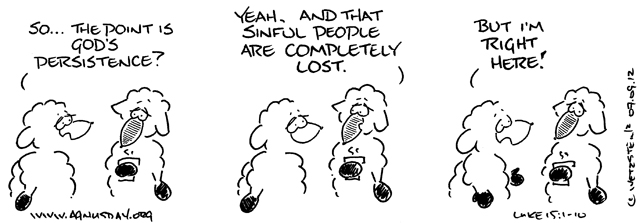
Lost Sheep










Aborigine Christians commented that the sheep was lost because it was not "doing what it was supposed to be doing" which, he went on to explain, was to be the sheshkebab! Desperate Preachers

Once there was a shepherd who had a hundred sheep. One of them went astray. The shepherd's colleagues figured this was probably due to some carelessness on the shepherd's part -- after all, when the shepherd had been a farmer, he had repeatedly been seen tossing seed in the middle of paved parking lots and pigeon hangouts without much thought as to whether anything would actually grow there, so he had acquired a reputation for being a little loopy.
The ninety-nine sheep, wanting to be helpful, immediately sprang into action ... or discussion, anyway. One loudly announced that the Historic Flock had never included more than ninety-nine sheep, and therefore that the stray was probably a goat, or perhaps a marmoset, and should not be bothered with. If a wolf got it, that's what it deserved for straying from the flock, or for being a marmoset, or whatever its problem was.
Factions gathered in response to that announcement, some suggesting that perhaps a message could be sent to the stray that if she were to stop being a marmoset and instead become a sheep, or at least learn to bleat like one, or perhaps if she stopped making...what noise is it that marmosets make? (cries immediately went up for a subcommittee to study that issue) she could rejoin the flock. A website and glossy magazine ads were put in place to further this effort, as were a series of dialogues, in which each member of a panel of three sheep would present its view of what species the strays were, followed by discussion and concluding with a very nice and moving liturgy.
Another faction formed to try to win over the first group. They poured their resources into a public relations campaign in the flock to celebrate the contributions of all sheep, even the ones reputed to be marmosets or goats. Since their raison d'etre was to convince the Historic Flockers, though, it was very important not to engage in any precipitous action that might offend them. So when rumors arose that the stray sheep was being attacked by wolves and a voice in the flock suggested that perhaps something ought to be done, another of the ninety-nine sheep produced a marvelous-looking PowerPoint presentation documenting the decline in wolf attacks by well over 30% over the last fifteen years. "And there used to be 78 strays per year," she noted, "that we've got it down to one is most impressive!" The faction responded with a loud cheer and rumbled off to a celebratory ball and fundraiser to cover the cost of a digital camera to supply graphics for future presentations.
All of this "pro-stray" rhetoric greatly annoyed the planners of the campaign to convince the stray to return to sheephood, and the sheep who didn't want the stray back in the flock at all were furious, threatening to leave the flock. Much hubbub ensued, and hours later, if you could somehow manage to listen beyond all of the loud bleating and blaring loudspeakers and committee deliberations and rousing choruses of "Bringing In the Sheep" and a new hymn, "Goading Out the Goats," you might have heard a few sheep quietly noting the shepherd's absence and wondering where the shepherd had gone, as one silhouetted figure made its way toward the horizon and the stray ... and some wolf howls echoed in the distance.
Three questions: